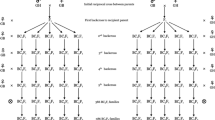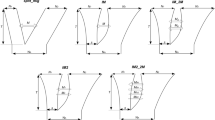Summary
The components of generation means that measure gene action and interaction at homozygous loci have expectations that depend on the degree of association or dispersion of alleles of like effect at different loci. With anything less than complete association, estimates of these components do not necessarily reflect the relative directions, magnitudes or kinds of gene action or interaction present. To illustrate these expected consequences, the F1, F2 and backcross generation of two contrasting crosses between pairs of inbred lines of Nicotiana rustica have been raised in which the same alleles are segregating at the same loci but for loci contributing to variation in final height the alleles of like effect are predominantly associated in one cross and predominantly dispersed in the other.
The simultaneous analysis of the data from the two crosses show all the expected effects of the differences in the degree of association or dispersion. In the dispersion cross the effects of gene action at homozygous loci are underestimated and the interaction between homozygous loci is not detected at all. The large directional dominance component that is common to both crosses is in fact no greater than the additive component once the deflating effect of dispersion is removed, thus ruling out the presence of overdominance.
No effects of association or dispersion on the components of variation could be detected nor would any be expected unless there were differences in the predominant linkage phase between the two crosses. Large and predictable effects on estimates of the number of effective factors are, however, demonstrable.
Similar content being viewed by others
Article PDF
References
Jinks, J L, and Jones, R M. 1958. Estimation of the components of heterosis. Genetics, 43, 223–234.
Jinks, J L, and Perkins, J M. 1969. The detection of linked epistatic genes for a metrical trait. Heredity, 24, 465–475.
Jinks, J L, and Perkins, J M. 1972. Predicting the range of inbred lines. Heredity, 28, 399–403.
Jinks, J L, Perkins, J M, and Pooni, H S. 1973. The incidence of epistasis in normal and extreme environments. Heredity, 31, 263–269.
Mather, K, and Jinks, J L. 1971. Biometrical Genetics, 2nd edition. Chapman and Hall, London.
Perkins, J M, and Jinks, J L. 1970. Detection and estimation of genotype-environmental, linkage and epistatic components of variation for a metrical trait. Heredity, 25, 157–177.
Perkins, J M, and Jinks, J L. 1973. The assessment and specificity of environmental and genotype-environmental components of variability. Heredity, 30, 111–126.
Author information
Authors and Affiliations
Rights and permissions
About this article
Cite this article
Jayasekara, N., Jinks, J. Effect of gene dispersion on estimates of components of generation means and variances. Heredity 36, 31–40 (1976). https://doi.org/10.1038/hdy.1976.3
Received:
Issue date:
DOI: https://doi.org/10.1038/hdy.1976.3
This article is cited by
-
Genetic analysis of grain yield and physiological traits of hybrid maize cv. SC704 under full and water deficit irrigation conditions
Cereal Research Communications (2021)
-
Genetics of fruit yield and its component traits under different fruiting habit backgrounds in chilli (Capsicum annuum L.)
Journal of Genetics (2019)
-
The in vitro genetics of barley (Hordeum vulgare L.): detection and analysis of reciprocal differences for culture response to 2,4-dichlorophenoxyacetic acid
Heredity (1987)
-
Anther culture of Hordeum vulgare L.: a genetic study of microspore callus production and differentiation
Theoretical and Applied Genetics (1987)
-
Comparison of associated and dispersed testers in the triple test cross
Heredity (1983)



